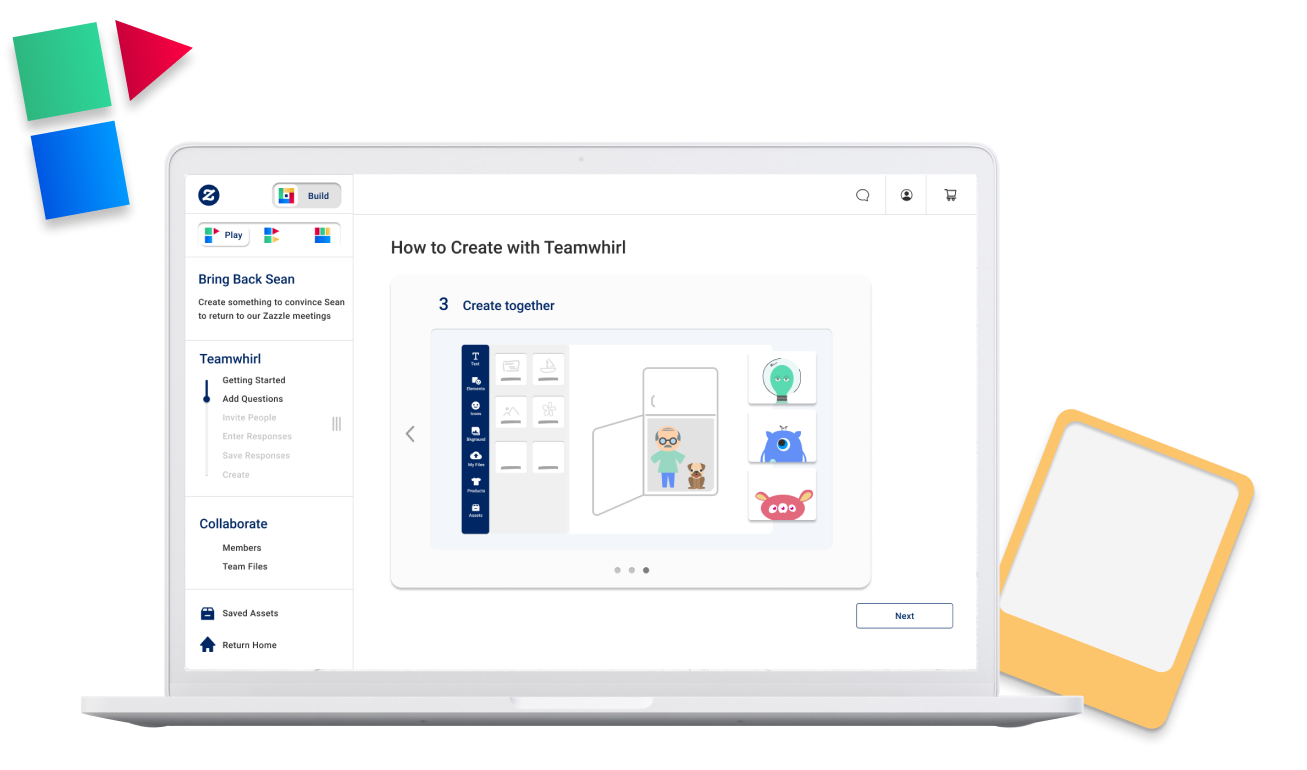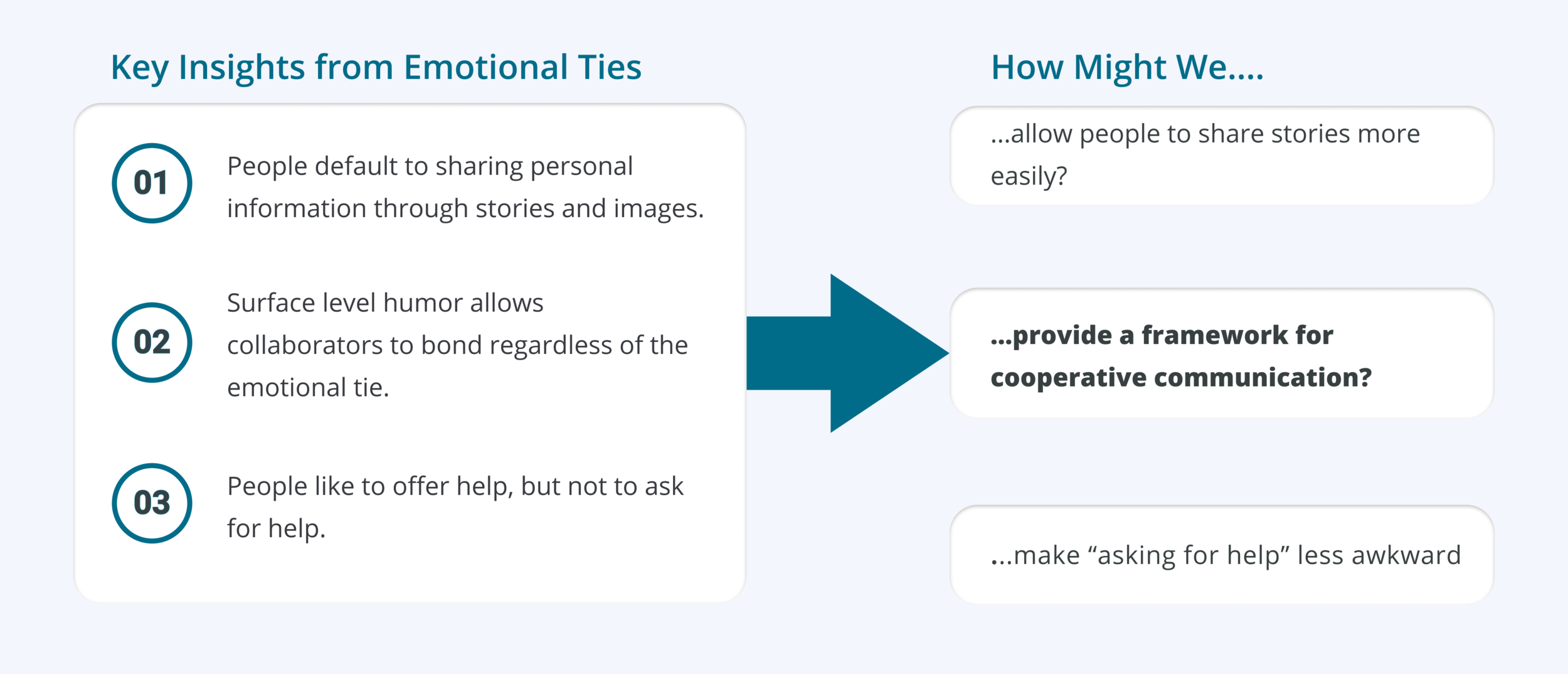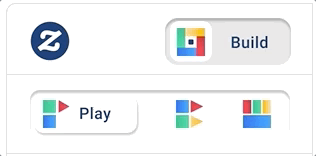Zazzle: Play
A platform built to facilitate and encourage remote collaboration and creativity.
Exploring creativity…
This 8-month long exploration of creativity and collaboration sought to unearth the universal challenges that people encounter in creative processes, while investigating how the existing Zazzle design tools can help to overcome them.
Team Members:
Timmy Chu, Alice Li, Hailey Motooka, Rituparna Roy, Nat Schade
*During this project, the team worked very collaboratively. All of the team members were involved in most of the aspects of the project, especially in the initial phases. Only during the final phases of the project were individual roles more defined.
My role in Zazzle Play:
UI design
Digital prototyping and usability testing
User experience research and synthesis
Turning research insights into design decisions
Iterative design
Tools:
Figma, Miro, Photoshop, Illustrator, Usertesting.com, Webflow, Zoom (for conducting remote user tests)
Methods:
Competitive analysis, Faculty interviews, Directed storytelling interviews, Experience prototypes, Affinity Diagrams, Speed dating, Storyboarding, Experience maps, Surveys, Rose Bud Thorn mapping, Think Aloud Protocol (TAP), Storyboards, A/B tests, and more
Project Overview
Zazzle paired up with our team to seek opportunities for growth as a creative platform. Zazzle is a print on demand company with a personal design platform that allows customers the freedom to design items for themselves.
Through an extensive and end-to-end iterative design process, the team researched, designed, tested, and delivered a proposal for a new solution to empower their user’s creativity head-on and expand opportunities for business and revenue in innovative ways.
User Research: Discovering the vast universe of creativity
Problem Space
Zazzle wants to make their platform into a creative community for its users, encouraging more creative lifestyles through daily doses of creativity. There is no single identifiable problem with creativity. Every person is capable of creative expression, though mediums, processes, outputs, etc differ from person to person. We dived into extensive research to discover opportunities among user pain-points.
Zazzle purposefully left the project brief open ended, allowing the team a lot of executive power to follow where the user research led.
Opportunity Space
The physical gifting experience is too narrow and specific for imparting additional value to the Zazzle platform. Over the course of the project, the team put together three overarching goals:
Put forward a plan to transform Zazzle into a creativity-focused platform, to differentiate them from others in the custom-product marketplace.
Gain/retain more users by helping to clearly identify users’ goals/purposes, discover the right tools, and get personalized outputs to optimize the experience.
Lower users’ barriers to creativity by providing fun and engaging brainstorming experiences to jump start the creation process.
Where do you start researching people and creativity?
Start by researching Zazzle itself
Our problem space is littered with what ifs -- questions that cannot be addressed, or even considered, without first understanding what is. From the kickoff meeting held with the clients in January, we were able to break down the internal workings of Zazzle into three fundamental elements: content, tools, and people. With a diverse set of existing tools in Zazzle’s toolshed, we directed our focus towards the content and people on Zazzle’s platform.
After meeting the clients, we started to ask ourselves: How might we encourage more creativity, facilitate collaboration and foster a Zazzle community?
Next up: directed storytelling research
Research Goals:
Understand current user behavior, preferences, pain-points, and needs in the space of creativity, collaboration, community, inspiration, and boredom
Identify common user themes in the mentioned spaces and find opportunities to impact users creative journey
Overview:
Research for this project started by looking into five distinct domains: collaboration, boredom, community, inspiration, and creativity. We started with over 20 hours of directed storytelling interviews. During the course of each individual interview, we asked the participants to detail their most recent experiences with collaboration, boredom, community, motivation, and creativity. The questions sought to provoke responses that would address the predefined research goals we had set prior to conducting the interviews.
After collecting rich qualitative data, we cleaned and organized them into white notes, which later transformed into affinity diagram.
Five initial domain areas: collaboration, boredom, community, inspiration, and creativity
Synthesizing the directed storytelling research through affinity diagramming
In order to synthesize the massive amount of data that we received from the interviews, the team undertook a massive affinity diagram. Our team worked together categorizing data and combing through patterns and moved up from white sticky notes to blue sticky notes, and blue to pink, pink to green.
Without disregarding our initial research goals, we approached the synthesis with an open mindset in order to recognize patterns and identify areas of interest that warrant more focused research efforts.
The top three levels of the Affinity Diagram are pictured above
Turning the Affinity Diagram into testable hypotheses
The affinity diagram synthesis gave rise to seven overarching themes (the green notes) that encompass common idiosyncrasies (from interviewees) that can be generalized to Zazzle users.
Turning How Might We statements into testable hypotheses
For each theme, we formulated hypotheses for further testing. To form the hypotheses, we generated How Might We statements, and transformed those into testable hypotheses.
Seven main hypotheses, derived from the Affinity Diagram themes
How do we test our hypotheses and assumptions?
Directed storytelling helped us identify seven potential directions to dive deeper. Next, considering one of Zazzle’s initial goals of creating a more cohesive community by bringing people, content and tools together, we used some generative methods (independent and based on hypotheses) to arrive at two design research studies.
Research Study: Emotional Ties
Emotional Ties is a research study designed to understand collaboration dynamics between friends when designing gifts for a variety of gift-receivers; the gift receivers have varying levels of emotional ties with the participants. We wanted to know how emotional ties affected the quality of the actual gift. The design of this prototype was largely informed by observed interactions on the newly launched tool, Zazzle Live. By creating a customer journey map, we were able to identify communication between customers and designers as a pain point to a successful Zazzle Live collaboration.
Hypothesis: The closer people mentally or emotionally come together, the more satisfying the gift they can create when working together.
Research Goals:
Understand whether emotional ties between the gift receiver and the gift giver facilitates communication between the designer and the gift giver.
Investigate what kind of information should be shared in a profile to better communicate one’s design vision.
Research Study: Shared Laughter
Shared Laughter sought to evaluate humor as an opportunity for strangers in collaboration to value the process over the outcome. We identified a moment of shared laughter between two strangers to be a small victory in the collaboration that can lead to increased trust, communication, and overall delight.
Hypothesis: Strangers are able to form relationships more quickly if they share moments of Shared Laughter
Research Goals:
Evaluate if humor is something that can bring strangers closer when collaborating
Determine if bonding through humor affects the quality of collaboration (how successful collaborators are at achieving their goal).
Synthesizing the research studies
Synthesizing Emotional Ties
After clustering and analyzing the data, we derived insights mainly under four major themes that were evident through most groups in the study. Information was a very important theme for this study, as a lot of interaction between designers relied in information sharing with each other. Other major themes that stuck out were work dynamics between the designers, moments of lowering the stakes for designing the gift, and personal branding.
The data indicated that as emotional ties between gift givers and gift receivers diminished, the less gift receivers think the gift givers know them and the less satisfied they are with the gift. To further investigate why, we dived deeper into qualitative and quantitative data from the gift givers’ side. Participants have the most difficulty brainstorming ideas when designing for strangers due to the lack of information. Though interestingly, due to the lowered stakes of designing for a stranger, the participants found this round to be the most fun. Overall, the lack of information when designing has negative effects on the receiver’s satisfaction.
Synthesizing Shared Laughter
Strangers felt more comfortable with each other after the shared laughter activity. People who were uncomfortable at the start about working with strangers became comfortable working with those same strangers after the activity.
After clustering and analyzing the data, we derived insights that were present in the majority of the groups. The top insights focused on laughter, disagreement and validation.
Ideation and Synthesis: Envisioning the future of Zazzle
After completing the research studies and synthesizing the insights gained, the main areas of opportunity that we identified were:
Connecting strangers and building a Zazzle community with non-monetary values.
Providing appropriate collaboration tools to help yield better group results.
Leverage bonds among sub-communities and host creative spaces.
Each area of opportunity resulted in a future that we envisioned for Zazzle based on our rigorous research and imagination. Imagine a future where people share stories as inspiration for each other, or a future where tools have the ability to break awkward silences, and reduce friction in collaboration. Alternatively, a future where Zazzle becomes the platform where sub communities can find their voice and solidify their identity. These three futures are not constraints to what Zazzle could be, but the beginnings of a brand new creative space.
Narrowing the Results
Now, we pushed forward to propose various ideas and conceptual prototypes based on the three proposed futures to help create value for Zazzle as a creative company. With multiple rounds of sketching, sharing of ideas, and voting, we forged ahead to validate the user needs behind those ideas. Using remote technology allowed us to reach out to a varied user base, and conduct speed-dating sessions to gather data on user needs and preferences.




Introducing the ‘Blank Canvas Dilemma’
Main causes of ‘Blank Canvas Dilemma’:
Too many options to choose from at the start
Not knowing what’s the starting point of creation
Paralyzing fear of not meeting expectations
We first encountered the ‘Blank Canvas Dilemma’ during the directed storytelling interviews. This is a specific type of creative mental block that happens at the start of creation. Time and again our research has showed that people struggle to start creating.
Additionally, a phase determination survey found that ~50% of the participants considered brainstorming to be the hardest part of the process. By mapping out a typical Zazzle customer experience and synthesizing the survey, we examined the root causes behind people’s troubles with getting started and ideating.
Experience Mapping
After we went through months of research into the various ways that people express creativity in groups and their creative processes, we put together this experience map, detailing the process from start to finish. People get stuck in the brainstorming and exploration phases most frequently.
In order to help people break past the brainstorming and exploration phase barrier, the team set out to change the order of the creative operations. The traditional order of operations starts with inspiration and ends with action. Instead, we’re changing the order and starting with actions; actions now lead to motivation and inspiration.
We then iterated activities for the stages of the user journey to bypass the problem areas where users tend to get stuck. We then storyboarded and tested the activities on Usertesting.com. We narrowed down the activities through user testing and client input to create initial prototypes of the most popular concepts.
Prototyping and Testing: activities to empower users’ creative confidence
Diagramming the flow
As we focused on activities that help users with brainstorming, the top two activities were Time Trinkets, and Teamwhirl. Time Trinkets is an activity that uses memory recollection to help in ideation, and Teamwhirl is a group brainstorming activity to generate relevant ideas. While both activities seek to facilitate brainstorming and jumpstart creative projects, they do so in very different ways. As a result, diagramming the user flows prior to designing was necessary in order to demonstrate the similar purpose, yet differing value of each activity. Both activities went through numerous rounds of iterations in transitioning from sketches to high-fidelity interfaces.
Based on the foundation of memories, Time Trinkets uses throwback items from the past as vessels to carry memories from user-inputted digital media. This user flow, in comparison to Teamwhirl, is more repetitive and therefore more straightforward. The goal was to emphasize low-effort for a high-quality output.
Based on the foundation of collaboration, Teamwhirl (originally called Pass It On) leverages the knowledge and perspectives of others as sources for inspiration. This user flow is diagrammed to consider how a Zazzle user would set up the activity, invite collaborators, and encourage invited collaborators to, ultimately, create.
The Low-Fi Prototype
We sought to make these activities fun and low-effort. The activities create a framework to spark creativity and provide variable outputs based on users’ preferences. The team started with low-fi designing of the prototype and refined it based on client feedback. Designing the user flows was key to identifying impact points. We conducted usability testing (TAP) to evaluate the usefulness and usability of our prototypes, and arrived at a strong user flow of the activities to start visualizing how it fits in the Zazzle ecosystem.



Medium Fidelity prototype testing
The highlights of the iteration from low-fidelity screens to get to medium fidelity focused on:
Addition of Onboarding from the landing page to Zazzle Play
Making the side navigation more informative
Adapting design components to optimize for the new user flows
The mid-fidelity screens used the flow to connect all of the disparate pieces into a single, interconnected system. A large goal for the mid-fidelity design changes was to increase the ease with which users transition between modes, tools, and activities.
Increased flexibility is essential to the users’ having a personalized Zazzle experience, which ends with their ideal output. In order to achieve that goal, the mid-fidelity prototype focused on fleshing out the path that users take to get to the specific activities. Specifically, we built out a new Zazzle landing page experience with on-boarding to direct visitors to the best activity for them.
Insights from Usability Testing
We conducted 4 usability testing sessions over a zoom call using an interactive prototype, designed in figma. The users were required to interact with the prototype for a set of tasks for them to accomplish. We asked some follow-up questions aftr the user went through each task.
We observed a number of issues with the flow and mismatch of users’ expectations. The following pages take you through those problems, what changes we made to tackle them, and the reasons for improvement.
Research Goals:
Test the usefulness and usability of the flow of activities - Teamwhirl & Time Trinkets
Test and understand the points of confusion or dropoff for participants
Identify places to add a fun element to the activity
Where does Zazzle Play fit in the Zazzle Platform?
Build and Browse
Adding fluidity between various Zazzle tools is achieved through the introduction of two modes: build vs. browse. Having two modes allows people to decide their purpose at the start of their visit to Zazzle, and access the tools relevant to their goals on the site.
Build and Browse is a re-structuring of Zazzle’s tools to align with user's goals. Ultimately rebranding Zazzle from a place to get creative stuff, to a place to do creative stuff.
User benefits of Build and Browse:
Prioritization of creative tools
Flexibility of exploration
Promotion of action-first
Goal Oriented user experience
Sample Activities in Zazzle Play
Zazzle Play is a collection of activities that facilitate brainstorming for creative projects by connecting users to the relevant resources at the right time. The system is made up of a variety of mini activities and design tools, designed to jumpstart the users’ creativity. Each activity stimulates the individual creation process to help users with brainstorming, while simultaneously producing some level of creative asset for the user. The user is then free to use the generated assets across Zazzle.
1. Team Whirl Collaboration Activity
Group collaboration helps draw inspiration from others, by gaining new perspectives and ideas. Team Whirl provides a fun guided experience to facilitate group ideation and creation.
Overarching Goal: Motivate users to continue activity by showing finished output in advance.
2. Time Trinkets Brainstorming Activity
Memory recollection trigger become a powerful and effective resource to generate ideas. Time Trinkets helps users evoke emotions, manifest stories, and build upon experiences to create a meaningful design.
Overarching Goal: Prompt users to reference their own artifacts or memories to spark brainstorming ideas.
Zazzle Play: The Final Prototype
The final prototype redesigns Zazzle’s information architecture according to the principles of the Build & Browse design, introduces a new brainstorming tool called Zazzle Play which is a system of activities that enable people to come up with ideas for creation, and a new navigation design to unify the tools on Zazzle’s platform. Combined together, this is a game-changer for rebranding Zazzle into a truly creative platform and for gaining competitive advantage with other custom product-based marketplaces.
👈Click through the interactive prototype. If you get stuck, click on blank areas of the prototype page to show hotspots, revealing clickable areas.
































